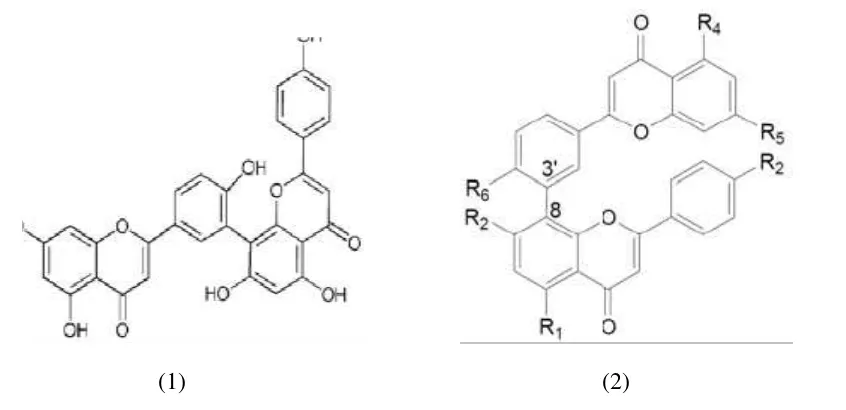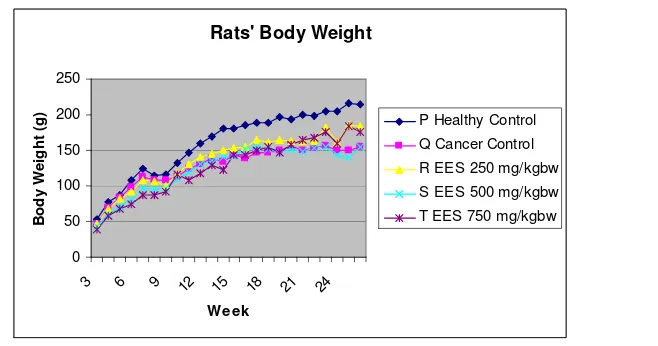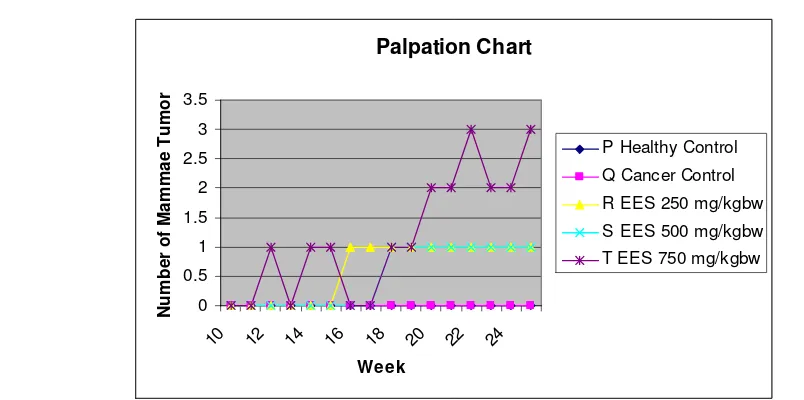Effects of Ethanolic Extract of
Selaginella
sp. on DMBA-induced
Carcinogenesis in Female Sprague Dawley Rats
Tri Yuliani*, S. Handayani, M. Angelina, I.D. Dewijanti
Research Center for Chemistry - Indonesian Institute of Sciences * corresponding author, email: anik_baik@yahoo.com
Abstract
Our previous study shown that ethanolic extract of Selaginella sp. (EES) has cytotoxic activity against cancer cell. In this current study, its effects on DMBA-induced tumor in female Sprague Dawley rats in vivo were investigated. The rats were divided randomly into 5 groups (8 rats each) named P (healthy control), Q (cancer control), R (treatment group, EES Dose 250 mg/kgbw), S (treatment group, EES Dose 500 mg/kgbw), and T (treatment group, EES Dose 750 mg/kgbw). EES in aquadest solution was administered orally for 7 weeks. DMBA in corn oil solution as tumor inducer was administered orally in 3 times. The rats were checked daily for mammary tumors by palpation after 7 weeks administration for 16 weeks. Macroscopic observations on vital organs of the rats were done during necropsy. This study showed that the number of rats suffered from tumor was declined in the higher dose. The highest dose in treatment group had the smallest number of tumor compare to the other treatment groups, but gave the highest mortality (50%), though 25% rats had no tumor and showed great body weight gain. In summary, the highest dose had not shown significant chemoprevention activity yet. Further study using higher doses is needed.
Keywords: rats, tumor, DMBA, mortality, Selaginella sp.
INTRODUCTION
Research for new anti cancer compound has become crucial day after day because of increasing level of the carcinogenic and mutagenic substances in the environment (Hafidh et al, 2009). In Indonesia, cancer is on the 7th death causes after Diabetes Mellitus (Depkes RI, 2008). Bioactive anti cancer compound from natural products is interesting to be studied due to wide side effect of and the resistance of cancer cell to the synthetic chemotherapeutic agents (Hafidh et al, 2009). Selaginella sp. grows widely in Indonesia and contains many bioactive compounds such as flavonoid, alkaloid, and terpenoid. Biflavonoid is the major bioactive compound in it, which comprises 13 compounds, especially amentoflavone and ginkgetin (Setyawan1, 2011).
Amento-flavone inhibits tumor metastasis in vivo by decreasing the mRNA expression of MMP-2, MMP-9, prolyl hydroxylase, lysyl oxidase, VEGF, ERK-1, ERK-2, TNF-alpha, IL-1beta, IL-6, and GM-CSF and increasing the mRNA expression of STAT-1 and nm23 in lung tissues with attenuation of tumor invasion, proliferation and angiogenesis as the results (Guruvayoorappan and Kuttan, 2008). Meanwhile, isoginkgetin inhibits tumor invasion in cancer cell by regulating PI3K with decreasing MMP-9 expression as a result (Yoon et.al., 2006). Our previous study shows that EES has cytotoxic activity against cancer cell T47D, HL-60 and YMB-1, with IC50 7 g/ml, 20 g/mL,
(1) (2)
Figure 1. Structures of amentoflavone (1)and ginkgetin (2) (Setyawan2, 2011).
MATERIALS AND METHODS Chemicals and biochemicals
Dried Selaginella sp. was obtained from Balitro (Bogor, Jawa Barat). DMBA was obtained from Tokyo Kasei. Etanol p.a. and Diethyl ether p.a were obtained from Merck. Bouin solution was obtained from Department Biology University of Indonesia (Depok, Jawa Barat). Rat feeding 23% protein were obtained from Indofeed (Bogor, Jawa Barat). All other materials were of the highest quality available from commercial suppliers.
Ethanolic extract of Selaginella sp. (EES) was prepared by as mentioned in Handayani (2011). For oral administered to the animals, EES with varied concentration was diluted in aquadest and DMBA was dissolve in corn oil.
Animal treatment
Female SD rats, 40 days of age were obtained from Veterinary Faculty Bogor Agriculcural University (Bogor), and were acclimatized for a week before being used for the experiments, housed in a room with enough ventilation, food and aquadest were available ad libitum, and maintained on a 12 h light/12 h dark schedule. Weight gain was measured every week along the experiment. Method for induction of carcinogenesis was adopted from Angelina
(2010) with modifications. The rats (40 rats) were divided randomly into 5 groups as follows:
Group P: healthy control rat. Per oral administration of 1 ml aquadest was given to the rats for 7 weeks (3rd week until 9th week). In 5th, 8 th, and 14 th week the rats were given per oral administration of 1 ml corn oil (vehicle control). Tumors were detected by palpation on the mammary glands from 10th week until 25th week.
Group Q: cancer control rat. Per oral administration of 1 ml aquadest was given to the rats for 7 weeks (3rd week until 9th week). In 5th, 8th, and 14th week the rats were given per oral administration of DMBA in 1 ml corn oil (15 mg/rat, 10 mg/rat, and 15 mg/ rat respectively). Tumors were detected by palpation on the mammary glands from 10th week until 25th week.
Group S: Medium dose treatment mammary glands from 10th week until 25th week. mammary glands from 10th week until 25th week.
In the 28th week, the rats were sacrificed with ether euthanasia and necropsy was done. Vital organs (lung, analyzed with statistic program (SPSS® 12 for Windows® software) using Kolmogorov-Smirnov Test followed by Tukey Test when the data were normally distributed or by Kruskal Wallis test
followed by Mann-Whitney Test when the data were not normally distributed, in order to find the difference between groups with confidence level 95%.
RESULTS AND DISCUSSION
Tumor was induced by DMBA (7,12-dimethylbenz[ ]anthracene) oral administration, polycyclic aromatic hydrocarbons compound which had been known as carcinogen by the activity of Cytochrome P450 (Kleiner et al, 2002). The induction of tumor is easier towards Sprague-Dawley Rats than Marshalls and August strain (Boyland and Sydnor, 1962). Estrogen promotes cell proliferation so that female and adults rats were used (Morales et al, 1995). Dose for EES administration carcinogen (Sadek and Abdul-Salam, 1994).
Rats’ body weight data are shown in figure 2.
The data were analyzed using Kolmogorov-Smirnov Test, showing that they were normally distributed (p>0.05). The difference between each groups at week 3, 7, 15, and 25 were analyzed using Tukey Test to see the significance of the
Week 3 depicts the body weight before treatment. At week 3, the difference between healthy control versus each group and highest dose versus each group was significant (p<0.05). This was because rats in the healthy control group possess the highest body weight and rats in the highest doses possess the lowest body weight. However, rats in the other groups have no significant in difference (p>0.5). Week 7 depicts the body weight in treatment day. At week 7, the significant difference was rather complicated. Cancer control group and low dose treatment group had no significant difference with healthy control group (p>0.05). Meanwhile, significant differences occur in rat with medium dose and high dose versus healthy control (p<0.05). This show that rats received medium dose, moreover high dose, could not follow the growth of rats in healthy control group. Only rats from high dose of EES differ significantly with cancer control group. Week 15 depicts the body weight during palpation, six week after the last treatment. At week 15, it seems that rats in cancer control group has morphological change because their body weight gain could not follow the healthy control groups, showed by the significant difference of cancer control versus healthy control (p<0.05). At week 15, group with low dose was the only one which coul
follow the healthy rats in body weight gain (p>0.05). In addition, all groups had no significant difference compared to cancer control, except healthy control. Week 25 depicts the body weight before necropsy. At week 25, sixteen week after the last administration, only rats from cancer control groups and medium dose group differ significantly in body weight compared to healthy control group (p<0.05). All rats from treatment groups had no significant difference compared to cancer control. This shows that EES administration could improve rats’ health after DMBA administration from body weight perception. However, compared to cancer control, only healthy groups differ significantly (p<0.05), showing that the health improvement is not really good.
Collected vital organs and cancer suspected organ were weighed (Table 1) and analyzed.
Organ weights were analyzed using Kolmogorov-Smirnov Test, showing that they were normally distributed (p>0.05). All vital organ weight collected during necropsy (lung, liver, and kidney) were analyzed with Tukey Test, showing no significant difference (p>0.05). The data show that DMBA administration and EES administration did not affect significantly towards organ from its weights perception.
Table 1. Organ weight of rats in the study of EES
Group Lung (mg) Liver (mg) Kidney (mg)
P (Healthy Control) 2292.68±962.44 10399.35±1944.66 3186.60±3749.51 Q (Cancer Control) 1703.60±452.38 8046.70±2573.54 1546.95±393.80 R (EES 250 mg/kgbw) 3721.60±4341.09 6944.07±3228.93 1673.99±447.97 S (EES 500 mg/kgbw) 1753.53±338.67 8743.59±1215.75 1713.54±460.83 T (EES 750 mg/kgbw) 1936.95±294.87 9959.45±2329.38 1850.30±361.54
Table 2. Number of tumor observed with naked eye at necropsy
Group Number of Tumor Mammae Tumor
P (Healthy Control) 0 0
Q (Cancer Control) 1 0
R (EES 250 mg/kgbw) 14 8
S (EES 500 mg/kgbw) 17 10
Palpation Chart
Figure 3. Number of tumor palpated week by week
Number of tumors counted from macroscopic observation through vital organ and mammary gland were shown by table 2.
Number of total tumor were analyzed using Kolmogorov-Smirnov Test, showing they were normally distributed (p>0.05). Analysis with Tukey Test detected that low and medium dose compared to healthy control showed significant difference (p < 0.05). Total tumor on rats receiving high dose of EES was not significant compared to healthy control (p>0.05), also when it was compared to cancer control (p>0.05). This is because DMBA administration did not produce tumor significantly in the rats. Though EES low dose and medium dose administration with DMBA produced significant number of total tumor, the number of mammae tumor in the rats did not differ significantly compare to healthy control (p>0.05).
High dose of EES accelerates mammary tumor development in rats receiving DMBA. Palpation on mammary gland of the rats week by week was number of total tumor in it is the highest.
Table 3. Mortality and tumor incidence in improve body weight gain in rats receiving DMBA along the study, but not in dose dependent manner. Rats that received medium dose always differed significantly compared to healthy control. Meanwhile, rats that received high dose could follow the body weight gain of healthy control only at the end of the study. According to body weight gain, it seems that low dose of EES is the best dose for DMBA attacks. However, tumor incidence in rats with low dose was 100% with 25% rats died. Though DMBA administration could affect body weight gain in rats, it did not affect the organ weight (lung, liver, and kidney) in each rat, so did with EES treatment.
tumor and total tumor in this treatment group was the highest among the other groups. Meanwhile, rats receiving high dose had the lowest number of total tumor and mammae tumor with 75% tumor incidence but 50% mortality. However, body weight gain from the high dose rat was better than medium dose. High dose of EES apparently was the best dose toward DMBA attacks but EES itself could act as tumor precursor.
EES contains apigenin (Handayani, 2011), meanwhile Selaginella stautoniana
contains p-hydroxybenzoic acid (Feng et.al., 2011). Tumor precursor property from EES might be derived from apigenin which is classified as phytoestrogen (Rice and Whitehead, 2006). Rice and Whitehead (2006) stated that phyto-estrogens may increase proliferation in existing breast cancer in human. In addition, Pugazhendhi et.al. (2005) said that p-hydroxybenzoic acid has estrogenic activity and induce proliferation in human breast cancer cell lines. More over, there is a potential carcinogen in EES, because of tannin constituent in it (Setyawan2, 2011, cit. Chikmawati 2008). Pradhan et al (1974) reported that tannin containing fraction of some plants produced malign-ant fibrous histiocytomas after varying numbers of injections. However, decreas-ing number of total tumor and mammary tumor in highdose EES may be due to phytoestrogen constituent in it. Rice and Whitehead (2006) cit. De Lemos (2001) reported that genistein, phytoestrogen from soy, stimulated growth at low concen-trations, but at high concentrations inhibit-ed breast cancer growth in vivo.
CONCLUSION
EES acts as tumor precursor but not in dose dependent manner. EES with dose 750 mg/kgbw could not prevent tumor yet. Further study involving microscopic observation of vital organ is needed to Kemopreventif Ekstrak Etanol Daun Brucea javanica Merrill Terstandar pada Tikus Putih, Tesis, Fakultas MIPA UI, Depok.
Boyland, E., Sydnor K.L., 1962, The Induction of Mammary Cancer in Rats, Br J Cancer 16, 731-739.
Departemen Kesehatan Republik Indonesia, 2008, Laporan Hasil Riset Kesehatan Dasar Nasional, Jakarta : Depkes RI.
Feng W., Zhu, B., Zheng X., Zhang, Y., Yang, L., Li, Y.,2011, Chemical Constituents of Selaginella
stautoniana,Chinese Journal of
Natural Medicines 2011, 9(2):
0108−0111
Guruvayoorappan C, Kuttan G., 2008, Amentoflavone inhibits experimental tumor metastasis through a regulatory mechanism involving 2, MMP-9, prolyl hydroxylase, lysyl oxidase, VEGF, ERK-1, ERK-2, STAT-1, NM23 and cytokines in lung tissues of C57BL/6 mice, Immunopharmacol Immunotoxicol. 30(4):711-27.
Hafidh R.R., Abas F., Abdulamir A.S., Jahanshiri F., Abu Bakar F. and Sekawi Z., 2009, A Review: Cancer Research of Natural Products in Asia.
International Journal of Cancer
Research, 5: 69-82.
Handayani, S., 2011, Ekstrak Etanol Cakar Ayam (Selaginella sp.) Sebagai Obat Herbal Kanker Payudara, Laporan Penelitian, LIPI, Jakarta.
initiation, J.Chem Res Toxicol., 15(2), 226-35.
Morales, D.E., McGowan K.A., Grant, D.S., Maheshwari, S., Bhartiya, D., Cid, M.C., Kleinman, H.K., Schnaper, H.W., 1995, Estrogen Promotes Angiogenic Activity in Human Umbilical Vein Endothelial Cells In Vitro and in a Murine Model,
Circulation.,91, 755-763.
Pradhan S.N., Chung, E.B., Gosh, B., Paul, B.D., Govind, J.K., 1974, Potential Carcinogens. I. Carcinogenicity of Some Plant Extracts and Their Tannin-Containing Fractions in Rats,
JNCI J Natl Cancer Inst 52 (5):
1579-1582. doi: 10.1093/jnci/52.5.1579 Pugazhendhi D, Pope GS, Darbre PD.,
2005, Oestrogenic activity of p-hydroxybenzoic acid (common metabolite of paraben esters) and methylparaben in human breast cancer cell lines, J Appl Toxicol.;25(4):301-9.
Rice, S., Whitehead, S.A., 2006, Review: Phytoestrogens and breast cancer – promoters or protectors?,
Endocrine-Related Cancer, 13 995–1015
Sadek, I.A., Abdul-Salam, F., 1994, Effect of Dietary Fat on Toad Liver Tumor Induced by DMBA: Ultrastructural Studies, Histol Histopath., 9, 423-426. Setyawan1 A.D., 2011, Review: Recent
status of Selaginella (Selaginellaceae) research in Nusantara, Biodiversitas; 2(12): 112-124
Setyawan2 A.D., 2011, Review: Natural products from Genus Selaginella
(Selaginellaceae), Nusantara Biosci-ence 3(1), Pp.: 44-58



